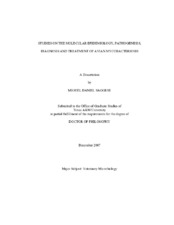| dc.description.abstract | We investigated the molecular epidemiology, differential susceptibility to infection and
disease, pathogenesis, diagnosis and treatment of avian mycobacteriosis in captive ringneck
doves (Streptopelia risoria) and in the endangered white-winged duck (Cairina
scutulata), both naturally infected with Mycobacterium a. avium. Our studies in doves
demonstrated lower susceptibility to infection and less severity of lesions in the white
color morph compared with the non-white. Genetic mechanisms of immunity to
mycobacteriosis may be contributing or determining these differences. Given that the
genes that code for white coloration are sex linked in birds, it is very likely that the gene or
genes modulating this different immune response to M. a. avium infection in these doves
could be associated to these loci or at least located in the same sexual (Z) chromosome, as
the association with white color suggest.
In the same birds, spleen biopsies followed by liver biopsies had the greatest potential for
the diagnosis of mycobacteriosis by the demonstration of acid-fast organisms. Additional culturing of spleen or liver biopsies significantly increased the diagnosis of
mycobacteriosis. The use of polymerase chain reaction (PCR) was the less sensitive
techniques. Uneven distribution and low number of organisms in the liver, spleen and
bone marrow may have contributed with the low diagnostic value of PCR.
In a second group of sixteen doves with mycobacteriosis from the same flock, the
combination of azithromycine, ethambutol and rifampin for 180 days was well tolerated
but failed to cure them. Furthermore, this study demonstrated the inefficacy of liver biopsy
to evaluate treatment as well the presence of antibiotic resistance in two isolates. These
results highlight that erradication of mycobacteriosis in birds is not easy to achieve.
Together with the possible emergence of antibiotic resistance in potentially zoonotic
mycobacteria our results suggest that the treatment of mycobacteriosis in birds should not
be recommended.
Finally, the last study shows that white-winged ducks are highly susceptible to at least two
sequevars of M. a. avium and that mycobacteriosis is a major threat to the ex situ
conservation program. The minimal heterozygosis previously shown in these ducks could
be contributing to this apparently ineffective immune response. | en |


